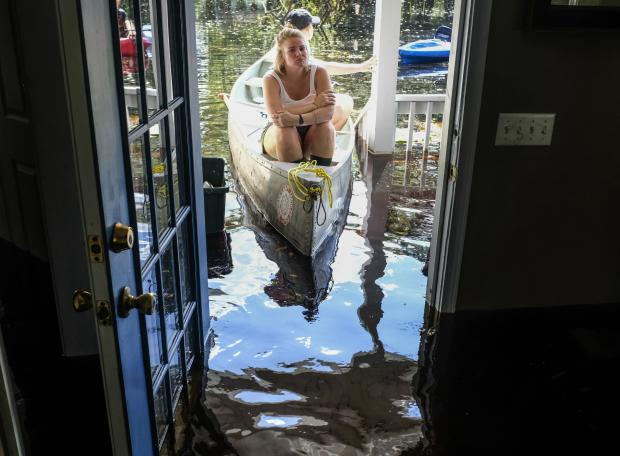After the hurricane comes the deluge on South Carolina coast

Maura Walbourne sits in the front of a canoe looking in at her flooded Long Avenue home as David Covington wades through the wreckage in Conway, South Carolina, on Sunday, Sept. 23, 2018. The Sherwood Drive area of Conway began to look like a lake on Sunday as homes were submerged deeper than ever in flood waters that have already set historic records. (Photo by JASON LEE / The Sun News via AP)
GEORGETOWN, South Carolina — Eleven days ago, Lee Gantt was at a Hurricane Florence party in her neighborhood in Georgetown, where the story goes that some houses haven’t flooded from the Sampit River since they were built before the American Revolution.
She will spend Tuesday with sandbags, watching the nearby river rise from Florence’s heavy rains and seeing if the luck finally runs out on her home built on Front Street in 1737.
“We thought this might be coming. We just left everything up above the floor just like from the hurricane. I’m nervous. Can’t you see me shaking?” she said, stretching her arms out.
The Sampit is one of five rivers that reach the Atlantic Ocean in and near Georgetown on the South Carolina coast. And Hurricane Florence — which started with record rainfall in North Carolina — is expected to cause record flooding downriver in Georgetown County as its final act. So much water is coming that it is backing up other rivers that aren’t even flooding.
The county has recommended almost 8,000 people leave their homes — more than 10 percent of the population. Officials expect floodwaters to top several bridges, nearly cutting Georgetown County in two and leaving only one highway out during the expected crest early Thursday.
Article continues after this advertisementThe deluge has made its way so slowly down the Lumber, Pee Dee and Waccamaw rivers that the state last week released detailed maps on where it expects flooding.
Article continues after this advertisementUpstream in Horry County, the floodwaters have invaded close to 1,000 homes near Conway as the Waccamaw River was slowly making its way to a crest a full 4 feet (1.2 meters) over its record level set just two years ago after Hurricane Matthew.
But in North Carolina, Gov. Roy Cooper said it was time to start concentrating on recovery. “Florence is gone but the storm’s devastation is still with us,” Cooper said at a news conference.
About 400 roads across North Carolina remained closed due to the storm that’s claimed at least 46 lives since slamming into the coast Sept. 14. Crews have reopened the major highways closed in the storm. Interstate 95 was reopened to all traffic Sunday night for the first time since the floods, and Cooper said Monday that a previously closed portion of Interstate 40 had reopened sooner than expected.
Power outages and the number of people in shelters also were declining. Around 5,000 people were without power, down from a peak of about 800,000, and about 2,200 people were in shelters, compared with a high of around 20,000, the governor said.
In Washington, lawmakers considered almost $1.7 billion in new money for disaster relief and recovery. And the economic research firm Moody’s Analytics estimated that Florence has caused around $44 billion in damage and lost output, one of the 10 costliest U.S. hurricanes. The worst disaster, Hurricane Katrina in 2005, cost $192.2 billion in today’s dollars. Last year’s Hurricane Harvey cost $133.5 billion.
Down in Georgetown County, it is a disaster nearly two weeks in the making. Georgetown County spent days under hurricane warnings before Hurricane Florence made landfall about 110 miles (175 kilometers) up the coast near Wrightsville Beach, North Carolina.
The worst of the storm stayed well north, causing only minor flooding in Georgetown and some downed limbs.
“We had a hurricane party,” Gantt said. “Now I don’t know what to do.”
Several blocks up Front Street, the main business district was busy, but with people leaving. All along the sidewalk were piles of artwork, antiques, and boxes as owners emptied out their inventory to take to higher ground.
Tomlinson department store sent an empty truck normally used to stock stores and employees rushed to fill it with everything. The store has never flooded, but predictions call for up to 5 feet (1.5 meters) of water by Thursday. “The anticipation has been nerve-wracking. Though, I’m glad we had the time to do this,” said district manager Kevin Plexico.
Georgetown was positioning ambulances and firetrucks in the busy, tourist section along the beaches in case the floods cut off the U.S. Highway 17 bridges as expected. National Guard troops were prepared to float more equipment across the river if needed. Exhausted emergency officials said they have lived nothing but Florence for more than two weeks.
“The work has been done,” Georgetown Mayor Brendon Barber said. “We just need to pray.” /atm